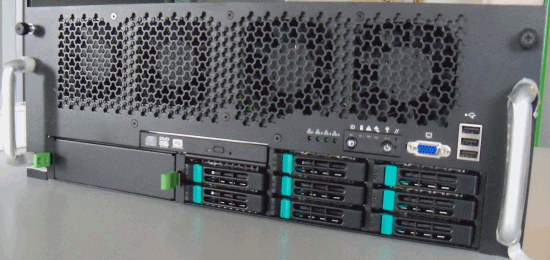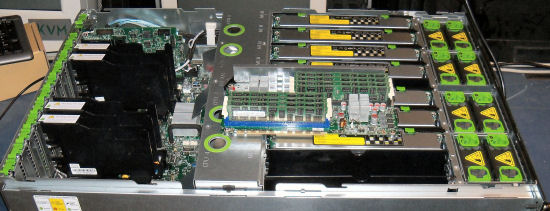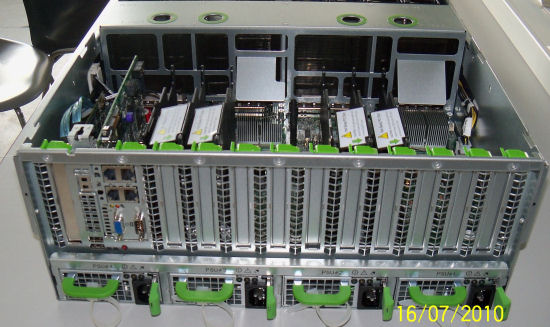Quad Xeon 7500, the Best Virtualized Datacenter Building Block?
by Johan De Gelas on August 10, 2010 5:10 PM EST- Posted in
- IT Computing
The 32-Core, 64-Thread Beast: QSSC-S4R
The heavy—50kg—QSSC-S4R server found its way to our lab. The ODM (Original Design Manufacturer) is the Taiwanese firm Quanta, who designed the server jointly with Intel. The 4U server is equipped for maximum expandability with 10 PCIe slots, quad gigabit Ethernet onboard, and 64 DIMM slots.

The enormous amount of DIMM slots is a result of the use of eight separate memory boards. Each memory board has two memory buffers and eight DIMMs onboard.

A 7+1 hot-swap, redundant fan module setup cools this system down. Notice that the disk system is not in front of the cooling as in most server systems. That is a plus, as the disks should not get the coldest air: disks perform best with medium temperatures (30-40°C, 86-104F) as the lower viscosity of the grease in the rotation motor puts less stress on the rotating components. Google’s study also suggests that disks should be kept at a higher temperature than the rest of the server.
The CPUs and DIMMs however should be kept as cool as possible to reduce the leakage power. The fans are well positioned: the memory boards and the heatsinks of the CPUs right behind them get the coolest air. In the back of the server you find the motherboard. You can see that the heatsinks on the 7500 chipset receive extra airflow.

Four 850W high efficiency power supplies feed this massive machine in a 2+2 or 3+1 configuration. You can find more detailed information about this QSSC-S4R server here. The other benchmarked configurations are identical to this page.










51 Comments
View All Comments
duploxxx - Thursday, September 2, 2010 - link
Looking at the differences between olap/oltp and web it is very clear that this web based test:The MCS eFMS portal, a real-world facility management web application, has been discussed in detail here. It is a complex IIS, PHP, and FastCGI site running on top of Windows 2003 R2 32-bit. Note that these two VMs run in a 32-bit guest OS, which impacts the VM monitor mode. We left this application running on Windows 2003, as virtualization allows you to minimize costs by avoiding unnecessary upgrades. We use three MCS VMs, as web servers are more numerous than database servers in most setups. Each VM gets two vCPUs and 2GB of RAM space.
is really in favor of intel cpu's this makes actually the final result a bit out of order....
database wise it would actually mean that you can order a L5640 or 6136 and you will have about the same virtualization performance, this means that it is only due to the web based vm behavior and results that you get such a difference. I think it is clear that although the vApus is a nice benchmark it should be enhanced more with different kinds of applications, the web based solution is providing in the end a wrong total conclusion.